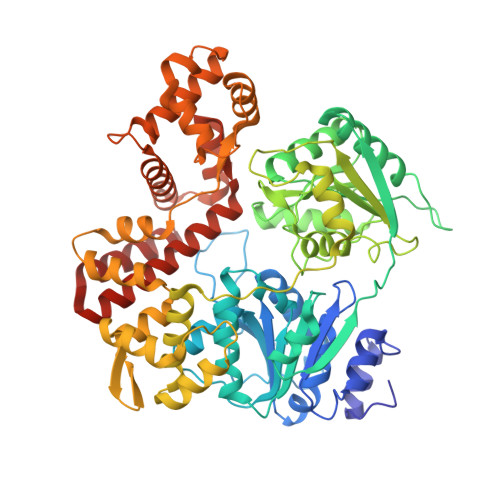The structure and activities of the archaeal transcription termination factor Eta detail vulnerabilities of the transcription elongation complex.
Marshall, C.J., Qayyum, M.Z., Walker, J.E., Murakami, K.S., Santangelo, T.J.(2022) Proc Natl Acad Sci U S A 119: e2207581119-e2207581119
- PubMed: 35917344
- DOI: https://doi.org/10.1073/pnas.2207581119
- Primary Citation of Related Structures:
7UJB - PubMed Abstract:
Transcription must be properly regulated to ensure dynamic gene expression underlying growth, development, and response to environmental cues. Regulation is imposed throughout the transcription cycle, and while many efforts have detailed the regulation of transcription initiation and early elongation, the termination phase of transcription also plays critical roles in regulating gene expression. Transcription termination can be driven by only a few proteins in each domain of life. Detailing the mechanism(s) employed provides insight into the vulnerabilities of transcription elongation complexes (TECs) that permit regulated termination to control expression of many genes and operons. Here, we describe the biochemical activities and crystal structure of the superfamily 2 helicase Eta, one of two known factors capable of disrupting archaeal transcription elongation complexes. Eta retains a twin-translocase core domain common to all superfamily 2 helicases and a well-conserved C terminus wherein individual amino acid substitutions can critically abrogate termination activities. Eta variants that perturb ATPase, helicase, single-stranded DNA and double-stranded DNA translocase and termination activities identify key regions of the C terminus of Eta that, when combined with modeling Eta-TEC interactions, provide a structural model of Eta-mediated termination guided in part by structures of Mfd and the bacterial TEC. The susceptibility of TECs to disruption by termination factors that target the upstream surface of RNA polymerase and potentially drive termination through forward translocation and allosteric mechanisms that favor opening of the clamp to release the encapsulated nucleic acids emerges as a common feature of transcription termination mechanisms.
- Department of Biochemistry and Molecular Biology, Colorado State University, Fort Collins, CO 80523.
Organizational Affiliation:
















